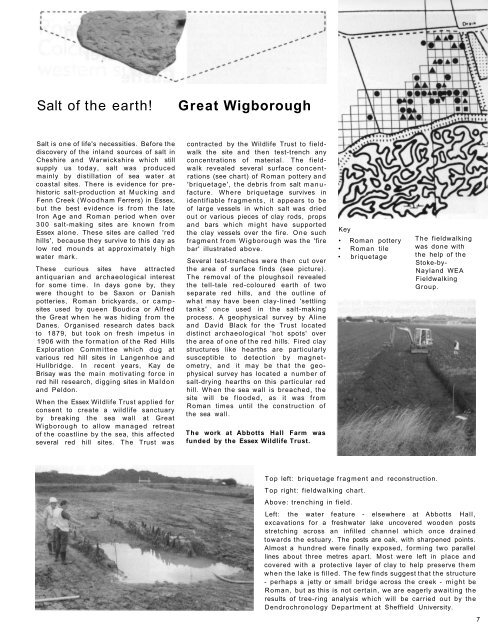The Colchester Archaeologist 2002 - Colchester Archaeological Trust
The Colchester Archaeologist 2002 - Colchester Archaeological Trust
The Colchester Archaeologist 2002 - Colchester Archaeological Trust
Create successful ePaper yourself
Turn your PDF publications into a flip-book with our unique Google optimized e-Paper software.
Salt of the earth!<br />
Great Wigborough<br />
Salt is one of life's necessities. Before the<br />
discovery of the inland sources of salt in<br />
Cheshire and Warwickshire which still<br />
supply us today, salt was produced<br />
mainly by distillation of sea water at<br />
coastal sites. <strong>The</strong>re is evidence for prehistoric<br />
salt-production at Mucking and<br />
Fenn Creek (Woodham Ferrers) in Essex,<br />
but the best evidence is from the late<br />
Iron Age and Roman period when over<br />
300 salt-making sites are known from<br />
Essex alone. <strong>The</strong>se sites are called 'red<br />
hills', because they survive to this day as<br />
low red mounds at approximately high<br />
water mark.<br />
<strong>The</strong>se curious sites have attracted<br />
antiquarian and archaeological interest<br />
for some time. In days gone by, they<br />
were thought to be Saxon or Danish<br />
potteries, Roman brickyards, or campsites<br />
used by queen Boudica or Alfred<br />
the Great when he was hiding from the<br />
Danes. Organised research dates back<br />
to 1879, but took on fresh impetus in<br />
1906 with the formation of the Red Hills<br />
Exploration Committee which dug at<br />
various red hill sites in Langenhoe and<br />
Hullbridge. In recent years, Kay de<br />
Brisay was the main motivating force in<br />
red hill research, digging sites in Maldon<br />
and Peldon.<br />
When the Essex Wildlife <strong>Trust</strong> applied for<br />
consent to create a wildlife sanctuary<br />
by breaking the sea wall at Great<br />
Wigborough to allow managed retreat<br />
of the coastline by the sea, this affected<br />
several red hill sites. <strong>The</strong> <strong>Trust</strong> was<br />
contracted by the Wildlife <strong>Trust</strong> to fieldwalk<br />
the site and then test-trench any<br />
concentrations of material. <strong>The</strong> fieldwalk<br />
revealed several surface concentrations<br />
(see chart) of Roman pottery and<br />
'briquetage', the debris from salt manufacture.<br />
Where briquetage survives in<br />
identifiable fragments, it appears to be<br />
of large vessels in which salt was dried<br />
out or various pieces of clay rods, props<br />
and bars which might have supported<br />
the clay vessels over the fire. One such<br />
fragment from Wigborough was the 'fire<br />
bar' illustrated above.<br />
Several test-trenches were then cut over<br />
the area of surface finds (see picture).<br />
<strong>The</strong> removal of the ploughsoil revealed<br />
the tell-tale red-coloured earth of two<br />
separate red hills, and the outline of<br />
what may have been clay-lined 'settling<br />
tanks' once used in the salt-making<br />
process. A geophysical survey by Aline<br />
and David Black for the <strong>Trust</strong> located<br />
distinct archaeological 'hot spots' over<br />
the area of one of the red hills. Fired clay<br />
structures like hearths are particularly<br />
susceptible to detection by magnetometry,<br />
and it may be that the geophysical<br />
survey has located a number of<br />
salt-drying hearths on this particular red<br />
hill. When the sea wall is breached, the<br />
site will be flooded, as it was from<br />
Roman times until the construction of<br />
the sea wall.<br />
<strong>The</strong> work at Abbotts Hall Farm was<br />
funded by the Essex Wildlife <strong>Trust</strong>.<br />
Key<br />
• Roman pottery<br />
• Roman tile<br />
• briquetage<br />
<strong>The</strong> fieldwalking<br />
was done with<br />
the help of the<br />
Stoke-by-<br />
Nayland WEA<br />
Fieldwalking<br />
Group.<br />
Top left: briquetage fragment and reconstruction.<br />
Top right: fieldwalking chart.<br />
Above: trenching in field.<br />
Left: the water feature - elsewhere at Abbotts Hall,<br />
excavations for a freshwater lake uncovered wooden posts<br />
stretching across an infilled channel which once drained<br />
towards the estuary. <strong>The</strong> posts are oak, with sharpened points.<br />
Almost a hundred were finally exposed, forming two parallel<br />
lines about three metres apart. Most were left in place and<br />
covered with a protective layer of clay to help preserve them<br />
when the lake is filled. <strong>The</strong> few finds suggest that the structure<br />
- perhaps a jetty or small bridge across the creek - might be<br />
Roman, but as this is not certain, we are eagerly awaiting the<br />
results of tree-ring analysis which will be carried out by the<br />
Dendrochronology Department at Sheffield University.<br />
7

















